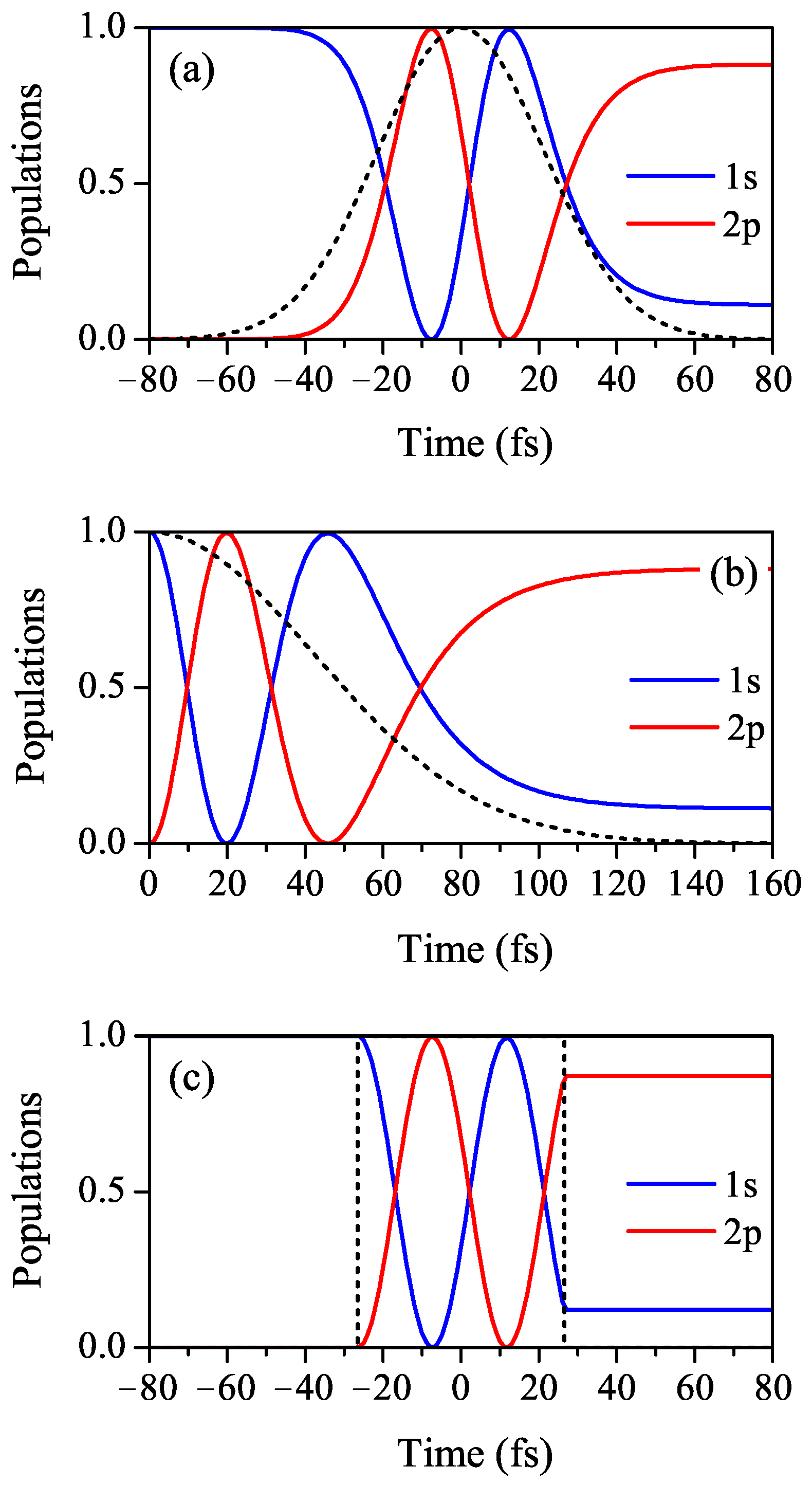Manifestations of Rabi Dynamics in the Photoelectron Energy Spectra at Resonant Two-Photon Ionization of Atom by Intense Short Laser Pulses
Abstract
1. Introduction
2. Calculation of Populations of Atomic States and Photoelectron Energy Spectra
2.1. The Three-Level Model
2.2. Results
3. Analysis of the AT Patterns in Terms of Dressed States
3.1. Dynamics of the Ground and Intermediate States
3.2. Dynamics of Continuum States
3.3. Analytical Solution for Rectangular Pulse
4. Summary and Conclusions
Author Contributions
Funding
Data Availability Statement
Acknowledgments
Conflicts of Interest
Abbreviations
| XUV | extreme ultraviolet |
| AT | Autler–Townes |
| PES | photoelectron energy spectrum |
References
- Rabi, I.I. Space Quantization in a Gyrating Magnetic Field. Phys. Rev. 1937, 51, 652. [Google Scholar] [CrossRef]
- Steck, D.A. Quantum and Atom Optics. Revision 0.13.4. Available online: Http://steck.us/teaching (accessed on 24 September 2020).
- Autler, S.H.; Townes, C.H. Stark Effect in Rapidly Varying Fields. Phys. Rev. 1955, 100, 703. [Google Scholar] [CrossRef]
- LaGattuta, K.J. Above-threshold ionization of atomic hydrogen via resonant intermediate states. Phys. Rev. A 1993, 47, 1560–1563. [Google Scholar] [CrossRef] [PubMed]
- Girju, M.G.; Hristov, K.; Kidun, O.; Bauer, D. Nonperturbative resonant strong field ionization of atomic hydrogen. J. Phys. B 2007, 40, 4165. [Google Scholar] [CrossRef]
- Nandi, S.; Olofsson, E.; Bertolino, M.; Carlström, S.; Zapata, F.; Busto, D.; Callegari, C.; Di Fraia, M.; Eng-Johnsson, P.; Feifel, R.; et al. Observation of Rabi dynamics with a short-wavelength free-electron laser. Nature 2022, 608, 488. [Google Scholar] [CrossRef] [PubMed]
- Rogus, D.; Lewenstein, M. Resonant ionisation by smooth laser pulses. J. Phys. B 1986, 19, 3051–3059. [Google Scholar] [CrossRef]
- Demekhin, P.V.; Cederbaum, P.V. Coherent intense resonant laser pulses lead to interference in the time domain seen in the spectrum of the emitted particles. Phys. Rev. A 2012, 86, 063412. [Google Scholar] [CrossRef]
- Müller, A.D.; Kutscher, E.; Artemyev, A.N.; Cederbaum, L.S.; Demekhin, P.V. Dynamic interference in the resonance-enhanced multiphoton ionization of hydrogen atoms by short and intense laser pulses. Chem. Phys. 2018, 509, 145. [Google Scholar] [CrossRef]
- Tóth, A.; Csehi, A. Probing strong-field two-photon transitions through dynamic interference. J. Phys. B At. Mol. Opt. Phys. 2021, 54, 035005. [Google Scholar] [CrossRef]
- Fischer, K.A.; Hanschke, L.; Kremser, M.; Finley, J.J.; Müller, K.; Vučković, J. Pulsed Rabi oscillations in quantum two-level systems: Beyond the area theorem. Quantum Sci. Technol. 2018, 3, 014006. [Google Scholar] [CrossRef]
- Demekhin, P.V.; Cederbaum, L.S. Dynamic Interference of Photoelectrons Produced by High-Frequency Laser Pulses. Phys. Rev. Lett. 2012, 108, 253001. [Google Scholar] [CrossRef] [PubMed]
- Demekhin, P.V.; Cederbaum, L.S. ac Stark effect in the electronic continuum and its impact on the photoionization of atoms by coherent intense short high-frequency laser pulses. Phys. Rev. A 2013, 88, 043414. [Google Scholar] [CrossRef]
- Baghery, M.; Saalmann, U.; Rost, J.M. Essential Conditions for Dynamic Interference. Phys. Rev. Lett. 2017, 118, 143202. [Google Scholar] [CrossRef] [PubMed]
- Jiang, W.C.; Burgdörfer, J. Dynamic interference as signature of atomic stabilization. J. Opt. Express 2018, 26, 19921. [Google Scholar] [CrossRef] [PubMed]
- Bunjac, A.; Popović, D.B.; Simonović, N.S. Analysis of the asymmetry of Autler-Townes doublets in the energy spectra of photoelectrons produced at two-photon ionization of atoms by strong laser pulses. Eur. Phys. J. D 2022, 76, 249. [Google Scholar] [CrossRef]
- Demekhin, P.V.; Cederbaum, L.S. Strong interference effects in the resonant Auger decay of atoms induced by intense X-ray fields. Phys. Rev. A 2011, 83, 023422. [Google Scholar] [CrossRef]
- Zhang, X.; Zhou, Y.; Liao, Y.; Chen, Y.; Liang, J.; Ke, Q.; Li, M.; Csehi, A.; Lu, P. Effect of nonresonant states in near-resonant two-photon ionization of hydrogen. Phys. Rev. A 2022, 106, 063114. [Google Scholar] [CrossRef]
- Meystre, P.; Sargent, M., III. Elements of Quantum Optics, 4th ed.; Springer: Berlin, Germany, 2007. [Google Scholar]




Disclaimer/Publisher’s Note: The statements, opinions and data contained in all publications are solely those of the individual author(s) and contributor(s) and not of MDPI and/or the editor(s). MDPI and/or the editor(s) disclaim responsibility for any injury to people or property resulting from any ideas, methods, instructions or products referred to in the content. |
© 2023 by the authors. Licensee MDPI, Basel, Switzerland. This article is an open access article distributed under the terms and conditions of the Creative Commons Attribution (CC BY) license (https://creativecommons.org/licenses/by/4.0/).
Share and Cite
Simonović, N.S.; Popović, D.B.; Bunjac, A. Manifestations of Rabi Dynamics in the Photoelectron Energy Spectra at Resonant Two-Photon Ionization of Atom by Intense Short Laser Pulses. Atoms 2023, 11, 20. https://doi.org/10.3390/atoms11020020
Simonović NS, Popović DB, Bunjac A. Manifestations of Rabi Dynamics in the Photoelectron Energy Spectra at Resonant Two-Photon Ionization of Atom by Intense Short Laser Pulses. Atoms. 2023; 11(2):20. https://doi.org/10.3390/atoms11020020
Chicago/Turabian StyleSimonović, Nenad S., Duška B. Popović, and Andrej Bunjac. 2023. "Manifestations of Rabi Dynamics in the Photoelectron Energy Spectra at Resonant Two-Photon Ionization of Atom by Intense Short Laser Pulses" Atoms 11, no. 2: 20. https://doi.org/10.3390/atoms11020020
APA StyleSimonović, N. S., Popović, D. B., & Bunjac, A. (2023). Manifestations of Rabi Dynamics in the Photoelectron Energy Spectra at Resonant Two-Photon Ionization of Atom by Intense Short Laser Pulses. Atoms, 11(2), 20. https://doi.org/10.3390/atoms11020020







